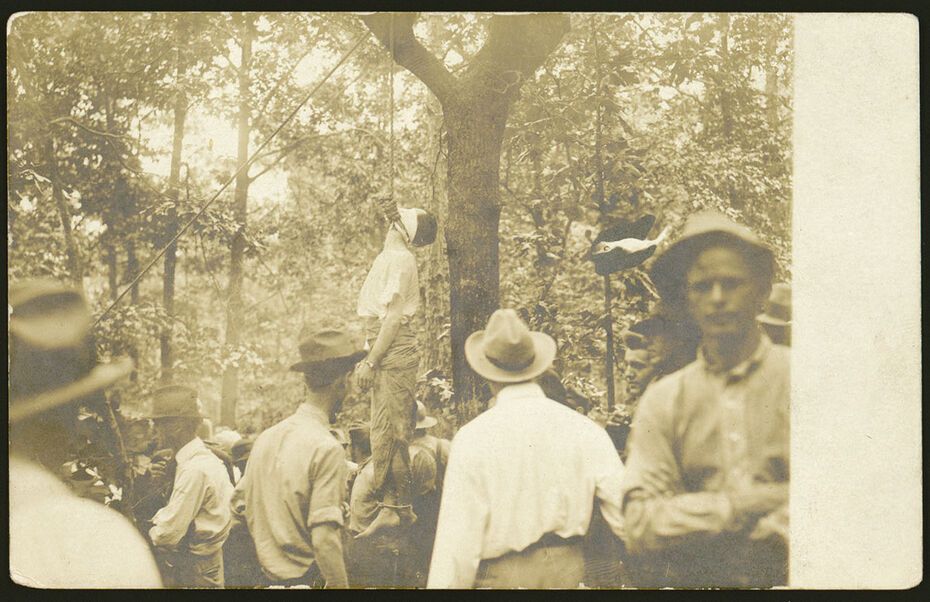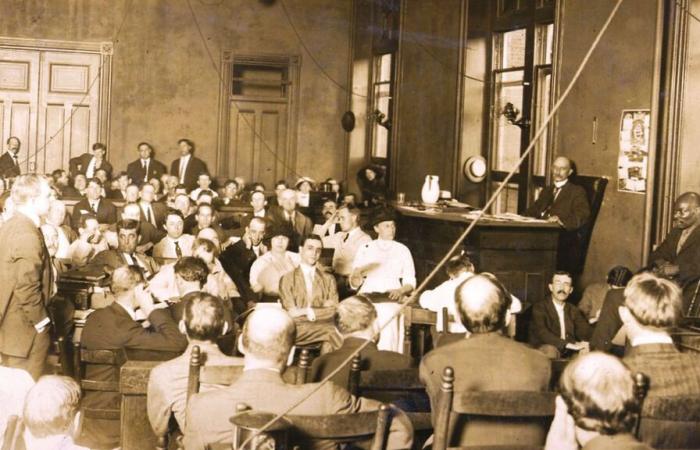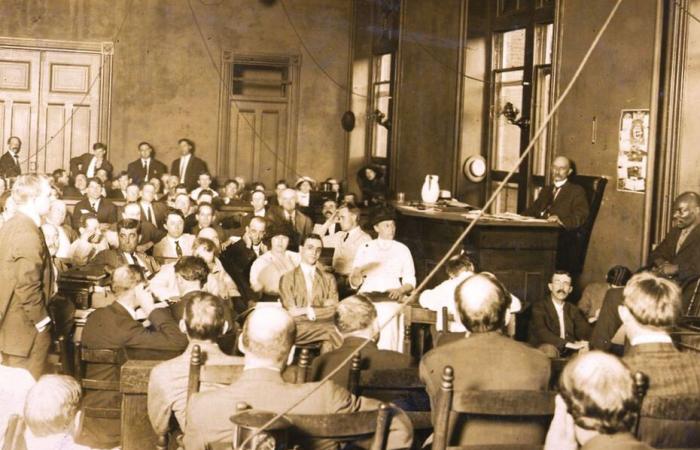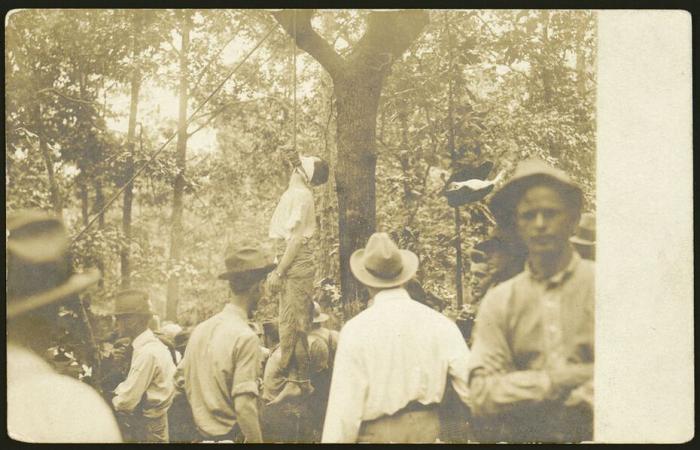This Saturday, April 26, 1913, workers from the National Pencil Company of Atlanta paraded into the office of Leo Frank, who distributed the paychecks. Shortly after noon, it was Mary Phagan’s turn to collect her dues. This week, the 13-year-old girl, who works on a knurling machine and inserts the metal ferrules for the erasers placed at the end of the pencils, will receive $1.20. Around 6:15 p.m., Frank leaves the factory, which he entrusts to night watchman Newt Lee, and returns home. The next day, the police asked him to accompany them. A body was discovered in the factory cellar, on the floor of the black toilets, near an incinerator. Mary Phagan was beaten, strangled and, according to initial evidence, raped.
Leo Frank would organize orgies in his factory, say some of his workers… © Library of Congress
A happy and uneventful industrialist…
Beside her are two letters she wrote, with these words: “I am being raped by a big black man.” If Lee is quickly exonerated thanks to his illiteracy and his regular clocking, Leo Frank appears to the police as nervous and distant. And therefore suspicious. Aged 29, the industrialist with a youthful and often impassive face is not very tall. A happily married man, without fuss, living in the nice neighborhoods of Atlanta. A brilliant Cornell student, he graduated in mechanical engineering and became a draftsman and test engineer for manufacturers of fans, then water meters. During a long trip to Europe, he trained in pen manufacturing in a factory in Hamburg. Which allowed him to take the reins of the National Pencil Co.
Despite his pedigree and his quiet life, Leo Frank was arrested on April 29. He is officially the last to see Mary alive. Here he is suspect number one. Tied with Jim Conley, one of the factory sweepers, arrested while washing his blood-stained shirt. Rust, nothing more, he defends himself. Except Conley is black, as described in the letter, an alcoholic and with a criminal record. A Jew and a black man. These are the two ideal suspects in a murder committed against a white minor. It doesn’t take much to set things on fire.
Some newspapers fiercely attack the suspects. Especially Leo Frank. Just think, he is Jewish.
Atlantans were outraged, the press took over and some newspapers fiercely attacked the suspects. Particularly Leo Frank. Just think, he is Jewish. And it is well known that people like him have unbridled sexuality due to circumcision, repressed homosexuality, a penchant for young girls… So many fantasized explanations, but considered plausible by the most radical press, which tend to prove Frank’s guilt. Moreover, around twenty workers say they have suffered the boss’s outrages. Nothing terrible, a hand on the shoulder, a steady look… Some even say that he organizes orgies in the factory after dark.
…become public enemy number one
Conley confesses and says he was paid by Frank to transport the body. The affair becomes national. Racism and anti-Semitism fuel the most outrageous comments, when facts are distorted to sell more and more newspapers. The pencil manufacturer is now accused of premeditated murder and will be charged on May 24. Soon the trial will begin. Leo Frank faces the death penalty.
Surrounded by his mother, his wife Lucille and his eight lawyers, Leo Frank looks like a good child who does not understand what is happening to him. In the stifling heat of July 28, 1913, the trial began in the Fulton County Superior Court, near Atlanta. The director of the National Pencil Company pencil factory is formally accused of having killed 13-year-old worker Mary Phagan. Outside, hundreds of people shout “Death to the Jew!”
Convinced of Leo Frank’s guilt [au centre, bras croisés]prosecutor Hugh Dorsey [debout, à gauche] receives the death sentence. © Walter Frank Winn – The Atlanta Journal
The prosecutor’s argument is clear: the black street sweeper Jim Conley is only a pawn manipulated by the depraved and vulgar Frank, the sole author of the crime.
While he has become public enemy number one and the target of the most virulent anti-Semites, the industrialist is supported by the Jewish leagues of Atlanta. The argument of prosecutor Hugh Dorsey is clear: the black street sweeper Jim Conley is only a pawn manipulated by the depraved and vulgar Frank, the sole author of the crime. He deserves to die. The line is strong, crude, because Dorsey plays big. The prosecutor has twice lost major criminal cases. A new failure would be the assurance of not being re-elected. Yet the evidence against Frank falters. Conley contradicts himself, the workers who had accused Frank of inappropriate actions retract… The defense accuses Conley, according to her, the sole author of the crime. But it doesn’t matter, everyone is already convinced of the industrialist’s guilt. At the judge’s request, Frank is absent when the verdict is announced to avoid any lynching. Here is the young director destined to be hanged. Justice is served. Head to the Georgian jails.
His lawyers appealed and the execution was postponed until April 17, 1914, his 30th birthday. At the same time, testimony and evidence mounted against Conley. But it’s too late for Frank. Only a request for commutation of his sentence can save him from death. The governor of Georgia, John Slaton, accepts and takes over the whole affair. He must act quickly, the new execution date, set for June 22, 1915, is fast approaching. The suspense is unbearable. He knows that his decision marks the end of his political career.
Public opinion wants him dead
On June 21, convinced of Frank’s innocence, Slaton commuted the death sentence to life in prison. Frank is saved from hanging. The reactions of public opinion were violent and the two men became the targets of the most enraged. Already condemned to the hatred of his fellow prisoners, Frank has his jugular cut by one of them with a 21 centimeter blade. He narrowly escapes. Until that famous night of August 16, 1915 when the 28 men took him out of his bed. Liberation?
Loaded into the back of a car, dressed in a simple nightgown, Frank knows his time has come. The dark procession rolls for 240 kilometers to Marietta, town of Mary Phagan. The one where she was born, the one where she is buried. After a mock trial, Leo Frank is hanged from a tree, bound hand and foot. The man swings in front of the ecstatic onlookers who have come with his family to enjoy the spectacle, tear off a piece of his shirt and photograph the dangling body. The photos become souvenir postcards.

Lynching of Leo Frank, August 17, 1915 in Marietta. © Library of Congress
The affair led to the creation of the Anti-Defamation League, to defend victims of anti-Semitism, and rekindled the fiery flames of the Ku Klux Klan. Leo Frank officially remains the culprit, even if everything suggests that Conley is the sole assassin. He will only serve one year in prison. Governor Slaton left Georgia for good and Attorney Dorsey took his place, before taking a seat on the Supreme Court. In the meantime, the National Pencil Co. sold its machines and went out of business.
 You are reading an article from L’Usine Nouvelle 3734 – September 2024
You are reading an article from L’Usine Nouvelle 3734 – September 2024
Read the summary









